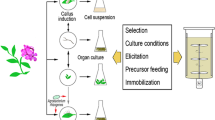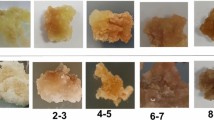Abstract
Cacti are an important source of metabolites but present limitations for their commercial exploitation, like slow growth and a decrease of wild populations. An alternative to obtain their biocompounds without affecting the natural environment are the in vitro culture techniques. We established in vitro cultures from Mammillaria candida Scheidweiler and Turbinicarpus laui Glass and Foster and used different stresses to increase metabolites and antioxidant activity. The cultures were exposed to 1.25% polyethylene glycol to induce a moderate drought stress, 50 g L−1 sucrose to generate an osmotic stress, chitosan (1.25 to 5 mg mL−1) to simulate a biotic attack, or to UV light. Chitosan was the best elicitor improving 1.5 times the concentration of phenolics, 9 to 10 times the content of flavonoids and betalains, and 16% the antioxidant activity in M. candida suspensions. In T. laui suspensions, this elicitor duplicates the flavonoids content and antioxidant activity. The antioxidant levels in elicited suspensions increased 5 to 10 times in relation to plant tubercles. Eleven compounds were identified in M. candida suspensions being digalloyl rhamnoside and epicatequin gallate the most abundant; in the T. laui suspensions, 16 compounds were detected and the most abundant were 17-decarboxi neobetanin and derivatives of luteolin. Thus, cacti in vitro culture is an efficient system to obtain high level of metabolites of biological interest.







Similar content being viewed by others

References
Ambigaipalan P, de Camargo AC, Shahidi F (2016) Phenolic compounds of pomegranate byproducts (outer skin, mesocarp, divider membrane) and their antioxidant activities. J Agr Food Chem 64:6584–6604. https://doi.org/10.1021/acs.jafc.6b02950
Akula R, Ravishankar GA (2011) Influence of abiotic stress signals on secondary metabolites in plants. Plant Signal and Behav 6:1720–1731. https://doi.org/10.4161/psb.6.11.17613
Antognoni F, Zheng S, Pagnucco C, Baraldi R, Poli F, Biondi S (2007) Induction of flavonoid production by UV-B radiation in Passiflora quadrangularis callus cultures. Fitoterapia 78:345–352. https://doi.org/10.1016/j.fitote.2007.02.001
Antunes-Ricardo M, Moreno-García BE, Gutiérrez-Uribe JA, Aráiz-Hernández D, Alvarez MM, Serna-Saldivar SO (2014) Induction of apoptosis in colon cancer cells treated with isorhamnetin glycosides from Opuntia ficus-indica pads. Plant Foods Hum Nutr 69:331–336. https://doi.org/10.1007/s11130-014-0438-5
Astello-García M, Cervantes I, Nair V, Santos-Díaz MS, Reyes-Agüero A, Guéraud F, Nègre-Salvayre A, Rossignol M, Cisneros-Zevallos L, Barba de la Rosa AP (2015) Chemical composition and phenolic compounds profile of cladodes from Opuntia spp. cultivars with different domestication gradient. J Food Compost Anal 43:119–130. https://doi.org/10.1016/j.jfca.2015.04.016
Banskota AH, Tezuka Y, Kadota S (2001) Recent progress in pharmacological research of propolis. Phytother Res 15:561–571. https://doi.org/10.1002/ptr.1029
Balen B, Tkalec M, Pavoković D, Pevalek-Kozlina B, Krsnik-Rasol M (2009) Growth conditions in in vitro culture can induce oxidative stress in Mammillaria gracilis tissues. J Plant Growth Regul 28:36–45. https://doi.org/10.1007/s00344-008-9072-5
Berger JM, Itagaki Y, Nakanishi K (2007) The effect of ultraviolet-depleted light on the flavonol contents of the cactus species Opuntia wilcoxii and Opuntia violacea. Chem Biodivers 4:1525–1532. https://doi.org/10.1002/cbdv.200790132
Cai Y, Luo Q, Sun M, Corke H (2004) Antioxidant activity and phenolic compounds of 112 traditional Chinese medicinal plants associated with anticancer. Life Sci 74:2157–2184. https://doi.org/10.1016/j.lfs.2003.09.047
Castellanos-Santiago E, Yahia EM (2008) Identification and quantification of betalains from the fruits of 10 mexican prickly pear cultivars by high-performance liquid chromatography and electrospray ionization mass spectrometry. J Agr Food Chem 56:5758–5764. https://doi.org/10.1021/jf800362t
Chappel J, Hahlbrock K (1984) Transcription of plant defence genes in response to UV light or fungal elicitor. Nature311:76–78. doi: https://doi.org/10.1038/311076a0
Chiu FL, Lin JK (2005) HPLC analysis of naturally occurring methylated catechins, 3‘ ‘- and 4‘ ‘-methyl-epigallocatechin gallate, in various fresh tea leaves and commercial teas and their potent inhibitory effects on inducible nitric oxide synthase in macrophages. J Agr Food Chem 53:7035–7042. https://doi.org/10.1021/jf0507442
Durner J, Wendehenne D, Klessig DF (1998) Defense gene induction in tobacco by nitric oxide, cyclic GMP and cyclic ADP-ribose. PNAS 95:10328–10333. https://doi.org/10.1073/pnas.95.17.10328
Esmaeelpanah E, Razavi BM, Vahdati Hasani F, Hosseinzadeh H (2017) Evaluation of epigallocatechin gallate and epicatechin gallate effects on acrylamide-induced neurotoxicity in rats and cytotoxicity in PC 12 cells. Drug Chem Toxicol 26:1–8. https://doi.org/10.1080/01480545.2017.1381108
Federspiel M, Fischer R, Hennig M, Mair MJ, Oberhauser T, Rimmler G, Albiez T, Bruhin J, Estermann H, Gandert C, Göckel V, Götzö S, Hoffmann U, Huber G, Janatsch G, Lauper S, Röckel-Stäbler O, Trussardi R, Zwahlen A (1999) Industrial synthesis of the key precursor in the synthesis of the anti-influenza drug oseltamivir phosphate (ro 64-0796/002, gs-4104-02): ethyl (3R,4S,5S)-4,5-epoxy-3-(1-ethyl-propoxy)-cyclohex-1-ene-1-carboxylate. OPR&D 3:266–274. https://doi.org/10.1021/op9900176
Ferrari S (2010) Biological elicitors of plant secondary metabolites: mode of action and use in the production of nutraceuticals. In: Giardi MT, Rea G, Berra B (ed.) Bio-farms for nutraceuticals, Springer-Landes Bioscience, pp 152–166
Ferri M, Tassoni A (2011) Chitosan as elicitor of health beneficial secondary metabolites in in vitro plant cell cultures. In: Mackay RG, Tait JM (eds) Handbook of chitosan research and applications. Nova Science Publishers Inc, New York, pp 389–414
Georgiev V, Ilieva M, Bley T, Pavlov A (2008) Betalain production in plant in vitro systems. Acta Physiol Planta 30:581–593. https://doi.org/10.1007/s11738-008-0170-6
González-Cabrera LD (2014) Efecto de reguladores del crecimiento exógenos sobre el desarrollo y la producción de metabolitos secundarios en cultivos de raíces transformadas de cactáceas. Dissertation University of Aguascalientes, México
Hollósy F (2000) Effect of UV radiation on plant cells. Micron 33:179–197. https://doi.org/10.1016/S0968-4328(01)00011-7
Inostroza-Blancheteau C, Reyes-Díaz M, Arellano A, Latsague M, Acevedo P, Loyola R, Arce-Johnson P, Alberdi M (2014) Effects of UV-B radiation on anatomical characteristics, phenolic compounds and gene expression of the phenylpropanoid pathway in highbush blueberry leaves. Plant Physiol Biochem 85:85–95. https://doi.org/10.1016/j.plaphy.2014.10.015
Khan MI, Harsha PS, Giridhar P, Ravishankar GA (2012) Pigment identification, nutritional composition, bioactivity, and in vitro cancer cell cytotoxicity of Rivina humilis L. berries, potential source of betalains. LWT-Food Sci Technol 47:315–323. https://doi.org/10.1016/j.lwt.2012.01.025
Lutty JM (2001) The cacti of CITES Appendix I. CITES Management Authority of Switzerland, Bern
Meda A, Lamien CE, Romito M, Millogo J, Nacoulma OG (2005) Determination of the total phenolic, flavonoid and proline contents in Burkina Fasan honey as well as their radical scavenging activity. Food Chem 91:571–577. https://doi.org/10.1016/j.foodchem.2004.10.006
Mikołajczyk-Bator K, Czapski J (2017) Effect of pH changes on antioxidant capacity and the content of betalain pigments during the heating of a solution of red beet betalains. Pol J Food Nutr Sci 67:123–128. https://doi.org/10.1515/pjfns-2016-0012
Murashige T, Skoog F (1962) A revised medium for rapid growth and bioassays with tobacco tissue cultures. Physiol Plant 15:473–497. https://doi.org/10.1111/j.1399-3054.1962.tb08052.x
Lu Y, Foo Y (2001) Antioxidant activities of polyphenols from sage (Salvia officinalis). Food Chem 75:197–202. https://doi.org/10.1016/S0308-8146(01)00198-4
Rabea EI, Badawy MET, Stevens CV, Smagghe G, Steurbaut W (2003) Chitosan as antimicrobial agent: applications and mode of action. Biomacromol 4:1457–1465. https://doi.org/10.1021/bm034130m
Robles-Martínez M, Barba-de la Rosa AP, Guéraud F, Negre-Salvayre A, Rossignol M, Santos-Díaz MS (2016) Establishment of callus and cell suspensions of wild and domesticated Opuntia species: study on their potential as a source of metabolite production. Plant Cell Tissue Organ Cult 124:181–189. https://doi.org/10.1007/s11240-015-0886-0
Santos-Díaz MS, Pérez-Molphe-Balch E, Ramírez-Malagón R, Núñez-Palenius HG, Ochoa-Alejo N (2010) Mexican threatened cacti: current status and strategies for their conservation. In: Tepper GH (ed), Species diversity and extinction, Hauppauge, NY:Nova Science Publishers, pp 1–60
Santos-Díaz MS, Velásquez-García Y, González-Chávez MM (2005) Pigment production by callus of Mammillaria candida Scheidweiler (Cactaceae). Agrociencia 39:619–626
Santos-Zea L, Gutierrez-Uribe JA, Serna-Saldivar SO (2011) Comparative analyses of total phenols, antioxidant activity, and flavonol glycoside profile of cladode flours from different varieties of Opuntia spp. Agric Food Chem 59:7054–7061. https://doi.org/10.1021/jf200944y
Sotomayor JM, Arredondo-Gómez A, Sánchez-Barra FR, Méndez-Martínez M (2004) The genus Turbinicarpus in San Luis Potosí. Venogno, Italy: Cactus & Co
Ŝtarha R, Chybidziurova A, Lacný Z (1999) Alkaloids of the genus Turbinicarpus (Cactaceae). Biochem Syst Ecol 27:839–841
Tan HP, Wong DZH, Ling SK, Chuah CH, Kadir HA (2012) Neuroprotective activity of galloylated cyanogenic glucosides and hydrolysable tannins isolated from leaves of Phyllagathis rotundifolia. Fitoterapia 83:223–229. https://doi.org/10.1016/j.fitote.2011.10.019
Waterhouse AL (2002) Determination of total phenolics. In: Current protocols in food analytical chemistry, New York: John Wiley & Sons, Inc, pp 1–8
Wybraniec S, Novak-Wydra B (2007) Mammillarinin: a new malonylated betacyanin from fruits of Mammillaria. J Agr Food Chem 55:8138–8143. https://doi.org/10.1021/jf071095s
Zaragoza-Martínez F, Lucho-Constantino GG, Ponce-Noyola T, Esparza-García F, Poggi-Varaldo H, Cerda-García C, Trejo-Tapia G, Ramos-Valdivia A (2016) Jasmonic acid stimulates the oxidative responses and triterpene production in Jatropha curcas cell suspension cultures through mevalonate as biosynthetic precursor. Plant Cell Tiss Organ Cult 127:47–56. https://doi.org/10.1007/s11240-016-1028-z
Zhao XM, She XP, Yu W, Liang XM, Du YG (2007) Effects of oligochitosans on tobacco cells and role of endogenous nitric oxide burst in resistance of tobacco to tobacco mosaic virus. J Plant Pathol 89:55–65
Funding
We are grateful to CONACYT for the scholarship to ARM (no. 401860).
Author information
Authors and Affiliations
Corresponding author
Ethics declarations
Conflict of interest
The authors declare that they have no conflict of interest.
Ethical approval
This article does not contain any studies with human participants or animals performed by any of the authors.
Additional information
Publisher’s note
Springer Nature remains neutral with regard to jurisdictional claims in published maps and institutional affiliations.
Electronic supplementary material
ESM 1
(PDF 252 kb)
Rights and permissions
About this article
Cite this article
Reyes-Martínez, A., Antunes-Ricardo, M., Gutiérrez-Uribe, J. et al. Enhanced production and identification of antioxidants in in vitro cultures of the cacti Mammillaria candida and Turbinicarpus laui. Appl Microbiol Biotechnol 103, 2583–2595 (2019). https://doi.org/10.1007/s00253-019-09656-8
Received:
Revised:
Accepted:
Published:
Issue Date:
DOI: https://doi.org/10.1007/s00253-019-09656-8



